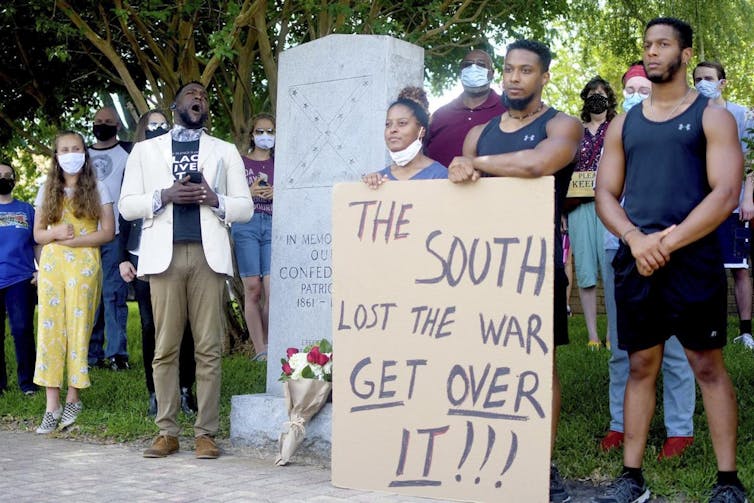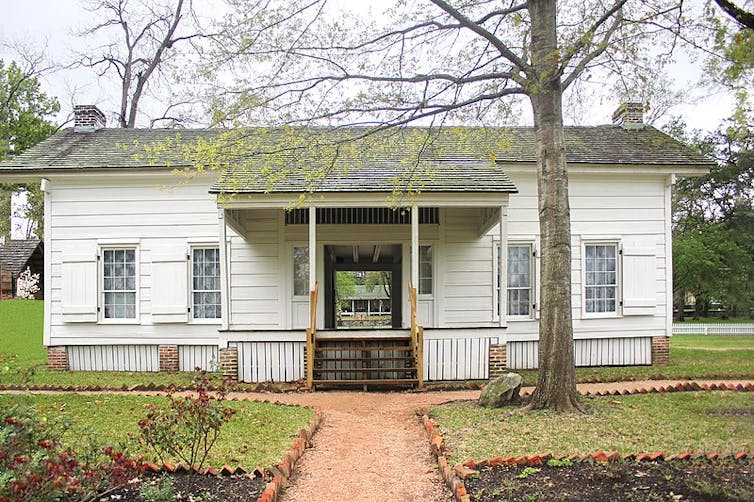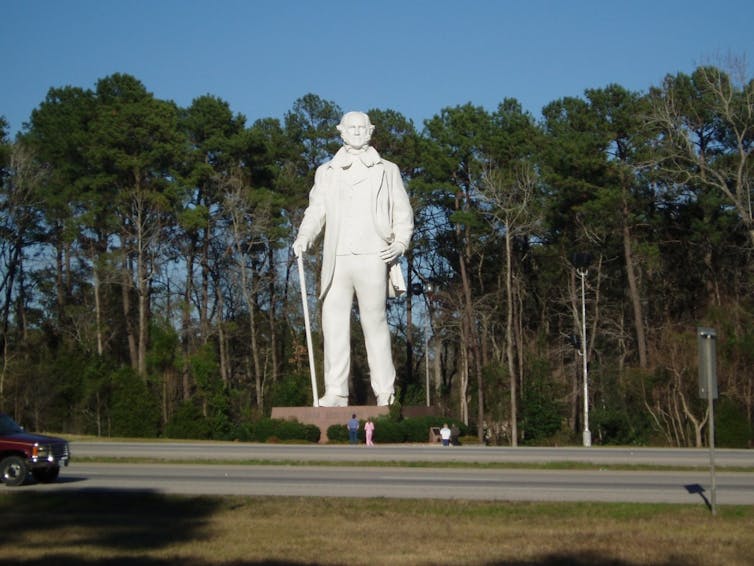Texas distorts its past – and Sam Houston's legacy – to defend Confederate monuments
- Written by Jeffrey L. Littlejohn, Professor of History, Sam Houston State University
At least 160 Confederate symbols were removed[1] from public spaces across the United States in 2020, according to the the Southern Poverty Law Center. Even Virginia, the former capital of the Confederacy, has removed a statue of Gen. Robert E. Lee from the Richmond Statehouse and is trying to take down others[2] seen as offensive by an increasing numbers of Americans, including those whose ancestors were enslaved.
Texas has largely declined to participate in this nationwide reckoning with the symbols of the Old South. Instead, local officials are doubling down on their Confederate monuments.
Republican State Sen. Brandon Creighton, who represents the city of Conroe, near Houston, says he will file a bill this legislative session[3] to protect historical monuments from efforts to remove them.
Meanwhile, officials in rural Walker County, Texas, voted unanimously[4] in December to keep a marker to “Confederate Patriots” on the county courthouse lawn in Huntsville. The vote followed an eight-month citizen campaign calling for the removal of the monument, which was erected by the United Daughters of the Confederacy in 1956.
Walker County Commissioners explained their Dec. 21 decision only by saying that the monument “does not belong to us,” suggesting it is a piece of local history.
Yet Walker County is hundreds of miles from any major Civil War battlefield. And the county’s most famous resident, Sam Houston, a Texas hero, ardently opposed the Confederacy.
So rejecting the Confederacy is Texas history, too.
 A protest in Huntsville, Texas, calling to remove a Confederate marker at the Walker County Courthouse.
Courtesy of Joseph Brown, The Huntsville Item, CC BY[5]
A protest in Huntsville, Texas, calling to remove a Confederate marker at the Walker County Courthouse.
Courtesy of Joseph Brown, The Huntsville Item, CC BY[5]
A proud Southerner who opposed secession
Sam Houston was the most important political figure in Texas[6] before the Civil War. The modern city of Houston is named for him, as is the university in Huntsville, Texas, where we teach American history.
Born in Virginia, Houston moved to the Mexican state of Texas in 1832. A veteran of the War of 1812, Houston was soon appointed commander of the Texas Army and helped secure Texas’ independence at the 1836 Battle of San Jacinto[7]. He went on to serve two nonconsecutive terms as president of the independent Republic of Texas.
Later, Houston was the state’s Democratic governor when secession became a serious subject of discussion in the South.
In 1860, following Abraham Lincoln’s election, white leaders in Huntsville wrote to Houston seeking his advice. Houston counseled them in a letter written on Nov. 14, 1860[8], to remain vigilant in their defense of American constitutional values “when the country is agitated and revolution threatened.” He urged the group not to get “carried away by the impulse of the moment.”
 Flag of the independent Republic of Texas.
troyek/E+ via Getty Images[9]
Flag of the independent Republic of Texas.
troyek/E+ via Getty Images[9]
There were natural bonds between Houston and Southern secessionists: All were white male slave owners who openly endorsed white supremacy. But Houston saw slavery as a necessary evil, not a patriotic cause.
“It is necessity that produces slavery[10],” he said in 1855, and “it is convenience, it is profit, that creates slavery.”
As a senator in 1854, he had voted against the extension of slavery into the Kansas and Nebraska territories[11] and was condemned throughout the South for his principled stand.
Sam Houston was no abolitionist, however. He owned more than a dozen enslaved people[12] and profited from enslaved labor throughout his life. Unlike much of America’s Southern gentry, though, Houston was not willing to shed blood to expand slavery.
When Texas legislators met in 1861 to consider seceding from the United States, Houston made clear his opposition to the move. But Texas secessionists were a stronger force. When Houston refused to take an oath to the Confederacy on March 16, 1861, he was removed from the governor’s office.
Booed by crowds and driven from state politics, Houston settled into a self-imposed exile in Huntsville. He watched in dismay as Texas joined the Confederacy[13]. He died two years later, a lonesome and broken man.
A contorted view of Texas history
As scholars who focus on race and class in Texas, we have studied the state’s history and have been led to speak out against Huntsville’s Confederate monument.
As we wrote last year in a statement published in the local newspaper[14], the Huntsville Item, the courthouse marker obscures and misrepresents local history. It is an insult to Houston’s refusal to pledge allegiance to the Confederacy and ignores the fact that enslaved African Americans made up most of Walker County’s population[15] during the Civil War.
It is, in so many words, an ahistorical monument.
Yet Huntsville – population 40,000 – glorifies Houston as a military and political hero. His former home is surrounded by a modern museum[16] dedicated to him. And Interstate 45, which runs from Houston to Dallas, features a 67-foot statue[17] known as “Big Sam” advertising Huntsville to travelers.
 Woodland, Sam Houston’s historic home in Huntsville, Texas.
Pma03/Wikimedia Commons, CC BY-SA[18][19]
Woodland, Sam Houston’s historic home in Huntsville, Texas.
Pma03/Wikimedia Commons, CC BY-SA[18][19]
How can modern Huntsvillians – like local officials across Texas – both revere this anti-Confederate leader and pledge their support for Confederate symbols?
The answer lies in the “Lost Cause[20],” a tenacious Southern myth that portrays slavery as benign and the Confederacy as noble. This is the preferred version of Texas history promoted by the state’s conservative leadership[21], the version that appears in Texas schools’ textbooks.
 ‘Big Sam,’ off I-45 outside Huntsville.
‘Big Sam,’ off I-45 outside Huntsville.
By the 1950s, when the Huntsville chapter of the United Daughters of the Confederacy erected the courthouse monument, the group had been pushing the Lost Cause narrative for over half a century[22].
Mae Wynne McFarland, a native Huntsvillian and 1941 president of the Texas Daughters of the Confederacy, characterized the “War Between the States”[23] as a conflict “fought for exactly the same principles which inspired the American Revolution, the War of 1812 and the Texas Revolution.”
Houston fought in two of those three battles. His repeated public statements show, however, that he did not believe the Confederacy’s effort in the Civil War aimed at the “same principles” as the War of 1812 or the Texas Revolution.
Conservative white Texans have long tried to knit Sam Houston into their Lost Cause narrative. But biographers and students of history have always been there to correct them.
[Deep knowledge, daily. Sign up for The Conversation’s newsletter[24].]
References
- ^ At least 160 Confederate symbols were removed (www.splcenter.org)
- ^ trying to take down others (theconversation.com)
- ^ file a bill this legislative session (thetexan.news)
- ^ voted unanimously (www.itemonline.com)
- ^ CC BY (creativecommons.org)
- ^ most important political figure in Texas (www.google.com)
- ^ Battle of San Jacinto (www.tshaonline.org)
- ^ counseled them in a letter written on Nov. 14, 1860 (www.tsl.texas.gov)
- ^ troyek/E+ via Getty Images (www.gettyimages.com)
- ^ It is necessity that produces slavery (doi.org)
- ^ voted against the extension of slavery into the Kansas and Nebraska territories (www.senate.gov)
- ^ owned more than a dozen enslaved people (www.tshaonline.org)
- ^ joined the Confederacy (www.tshaonline.org)
- ^ statement published in the local newspaper (www.itemonline.com)
- ^ enslaved African Americans made up most of Walker County’s population (studythepast.com)
- ^ modern museum (www.samhoustonmemorialmuseum.com)
- ^ 67-foot statue (www.huntsvilletexas.com)
- ^ Pma03/Wikimedia Commons (www.khou.com)
- ^ CC BY-SA (creativecommons.org)
- ^ Lost Cause (www.vox.com)
- ^ preferred version of Texas history promoted by the state’s conservative leadership (www.washingtonpost.com)
- ^ been pushing the Lost Cause narrative for over half a century (www.vox.com)
- ^ characterized the “War Between the States” (archon.shsu.edu)
- ^ Sign up for The Conversation’s newsletter (theconversation.com)
Authors: Jeffrey L. Littlejohn, Professor of History, Sam Houston State University


